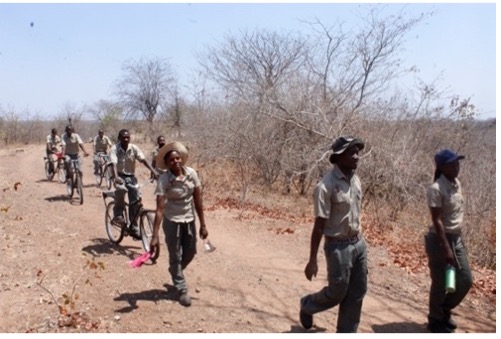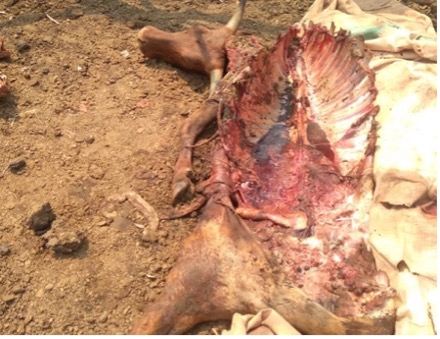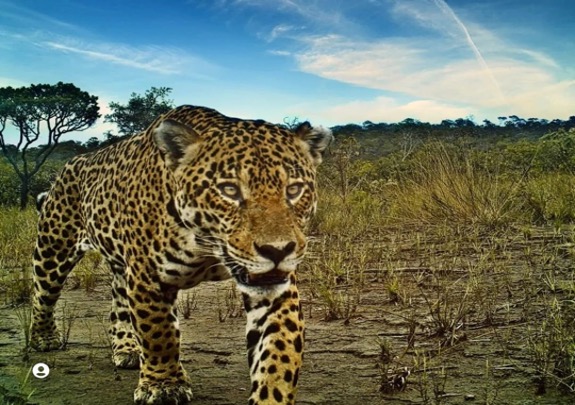News
Congratulations Diploma class of 2022
WildCRU’s Post-Graduate Diploma in International Wildlife Conservation Practice has achieved global recognition for excellence, providing training in all aspects of practical conservation to aspiring young conservationists from less-developed countries, especially focusing on the most talented and least privileged applicants who would not normally have the opportunity to attend a world-class university.
Our pride in the ‘WildCRU Panthers’, the students of the Recanati-Kaplan Centre Postgraduate Diploma in International Wildlife Conservation Practice, is limitless. Panthera, and in the early years, the Recanati Kaplan Foundation, have funded the full operational costs of the Diploma, including the conversion of the Panthera buildings that provide teaching space and accommodation, to the salaries of teaching staff, administrative support, student fees and stipends, since the very first cohort of students joined WildCRU for the intensive, residential course in 2008. To date we have trained 113 young men and women from 46 countries. In every case their Oxford experience has been life-changing and career building, elevating young conservationists from across the globe into world class practitioners. Our diaspora of Panthers remain connected via our Diploma social network and Panthers provide both horizontal and vertical support to their peers from the past as well as the future. The camaraderie and professional linkages are intense – the result is a global community of highly skilled and collaborative conservationists.
In the first week of October the 2022 cohort of students made their final presentations on their research projects to the WildCRU team. Most of our Diploma students bring data from their previous conservation activities to develop research projects whilst with WildCRU. This forms a significant part of the Diploma course work, and, with the support, mentorship and guidance of our team, sometimes culminates in a published scientific article, which is hugely beneficial for their career development. The day of their final presentations is an especially poignant moment in WildCRU’s calendar as we wish farewell to our latest friends and colleagues who have lived and worked amongst us for the last seven months. Here are some highlights from their research projects to celebrate their achievements in Oxford, compiled by Dawn Burnham.
Simbarashe Pride Chatikobo (Zimbabwe)
We first met Simba as a field assistant on WildCRU’s Hwange Lion Project. Since then he has developed his conservation interest in large carnivores and has been working with Wildlife Conservation Action – a Zimbabwe based NGO led by WildCRU alumna, Dr Moreangels Mbizah. For his project, Simba has investigated livestock attacks in the Nyaminyami rural district of Zimbabwe near Matusadonha National Park, titled ‘Predation risk modelling: an opportunity for coexistence between large carnivores and rural communities in Zimbabwe’. Of the 199 recorded livestock attacks he found that 105 were by lions and 94 by spotted hyenas, taking cows, goats and a surprisingly high number of donkeys compared to other areas. He found that croplands have the highest predation risk, but the number of livestock attacks reduced as you move further from the park boundary, further from roads, and further from water sources, making the areas near water sources particularly risky. This is a challenge for rural communities since water sources are shared between people, livestock and wildlife, inevitably leading to conflict. Simba’s recommendation from this research include an exploration of solar-powered boreholes for people and livestock, to limit sharing natural water sources with wildlife, ultimately mitigating against water driven conflict.
Letícia Benavalli (Brazil)
Letícia co-founded two NGOs in Brazil, both concerned with community engagement and sustainability in practical conservation, whilst working to reduce jaguar-human conflicts in the region. For her project she investigated ‘Jaguar movement in a mosaic of agricultural lands and protected area in the Brazilian savannah’, centred on the Emas National Park and surrounding private lands. She analyzed data from 12 GPS-collared jaguars, representing the largest dataset in the region. Letícia found that males moved further and had larger home ranges than females, and that private lands were important for jaguar land use near Emas National Park. Croplands negatively impacted jaguar movements, highlighting the importance of natural forest fragments within the mosaic of agricultural landscapes. This work highlights the need for conserving and expanding important forest fragments to aid the long-term conservation of jaguars in the southern Cerrado.
Harifetra Andrianandrianina Laza (Madagascar)
Laza is a research assistant with the Centre Valbio, an International Research Centre that operates in the rain forest of Ranomafana National Park. Laza worked with data from WildCRU’s long term clouded leopard study for his research project. He investigated the ‘Effects of African Swine Fever on the occupancy of the bearded pig and the Sunda clouded leopard in Sabah, Borneo’. African swine fever was officially declared in Borneo in February 2021, with reports of 303 domestic pigs and 5 wild pigs afflicted with the disease. However, field observers have reported less sightings of bearded pig and Sunda clouded leopard since mid-2020, and since the bearded pig is considered the likely main prey of Sunda clouded leopard in parts of Borneo, the potential link with the arrival of African swine fever is worrying. From three years of camera trapping data (2018 to 2021) from WildCRU’s Tawau highlands surveys in Sabah, Borneo, Laza found some evidence that bearded pig were likely affected by African swine fever as their occupancy in the area decreased. However, clouded leopard occupancy remained relatively unchanged, suggesting that so far that they may have altered their main prey in response to a decline in pigs.
Karma Choki (Bhutan)
Karma is a Forestry Officer with the Department of Forests and Park Services in Sarpang, Bhutan. For her research project she worked with camera trap data from Bhutan’s comprehensive National Tiger Survey, conducted in 2014-2015. Karma investigated the ‘Anthropic and environmental correlates of spatial interaction among small felids in a montane landscape’. The focal species were Asiatic golden cat, marbled cat and are leopard cat. Topographical slope had a strong influence on the occurrence of all three felids, both the Asiatic golden cat and the marbled cat were positively associated with slope whereas the leopard cat was not. This indicates the preference for similar, naturally rugged habitats at a landscape level by the Asiatic golden cat and marbled cat where the human footprint is generally low. Overall, Karma’s findings suggest that natural forests and protecting rugged landscapes will be crucial for small felid conservation. While human settlements are unlikely to expand into rugged landscapes, these terrains are often targeted for mining and quarrying, so limiting this type of conversion will be critical for small carnivore conservation.
Yves Olatoundji (Benin)
Yves is a biodiversity officer with Organisation pour le Développement Durable et la Biodiversité in Benin where he has led a number of wildlife surveys on mammals including primates, and rare ungulates, such as Walter’s duiker, of the Oueme Valley in southern Benin. For his project on the Diploma Yves used camera trap data on primates, ‘biodiversity by-catch’, from our long term study of Sunda clouded leopards in Borneo. He investigated ‘Factors explaining the distribution of southern pig-tailed macaque and long-tailed macaque in Tawau Highlands, Sabah, Malaysian Borneo’. Yves found that pigtailed macaques were more abundant than long-tailed macaques and the presence of both species appeared to be influenced by elevation, distance to road and distance to rivers. At higher elevations the two species were less likely to occupy the same areas, which may link to differences in food preferences and availability.
Asma Bileh Hersi (Somaliland)
Asma is a veterinarian working with the Cheetah Conservation Fund. Asma’s project is a case study in a key topic for conservation that links to a multibillion-dollar industry – wildlife trade, ‘Illegal cheetah trade and mortality in Somaliland.’ Her data spanned 16 years of cheetah confiscations, with the number of cubs seized per year ranging from two in 2006 to 39 in 2022. She found trafficked animals are mainly young cubs and most of which that are confiscated died within the first month, even if they were rapidly moved to a care home. Somaliland appears to be a main link in the international traffic route, with a hotspot of confiscations in the capital city, close to the boundary with Ethiopia. As well as improved law enforcement she recommends international collaborative action between Ethiopia, Djibouti and Somaliland to tackle the trade.
Rocio Bardales Zegarra (Peru)
Rocio is a field researcher with Panthera’s Conexion Jaguar Program in Peru. In 2019 the Pantanal suffered a severe drought followed by an increase of fires in 2020. For her research project Rocio analysed the impact of this in Serra do Amolar, ‘Effects of wildfires on a jaguar and ocelot population in the Pantanal, Brazil’. Using camera trap surveys before and after the fires she found that jaguar density was maintained whereas ocelot density decreased. For both jaguars and ocelots home range size increased after the fires, probably due to the need to search widely for prey.
Ding Nianfan (China)
Ding’s research in China focusses on human-wild boar conflict and species distribution models of snow leopard and Asian elephant. So far, estimates of the global population size of snow leopards are questionable as less than two percent of their range has been surveyed. Ding’s research project, ‘Snow leopard density and abundance estimation in Tianshan, northwest China’ contributes to this knowledge gap. The survey consisted of 300 camera trap sites over 4,000 km2 of suitable habitat. Seventy-five individual snow leopards were identified from their fur patterns, and this allowed for the most robust density estimation method based on individual recaptures. Ding calculated that there are likely to be 177 individuals spanning 15,688km2, with an average density of 1.12 individuals per km2 in Tianshan mountain range.
-
 WildCRU’s Diploma 2022 cohort during their field trip to Pembrokeshire in Wales. From left: Yves Olatoundji (Benin), Ding Nianfan (China), Simbarashe Chatikobo (Zimbabwe), Asma Bileh (Somaliland), Karma Choki (Buthan), Rocio Bardales (Peru), Leticia Benavalli (Brazil), Harifetra Laza (Madagascar).
WildCRU’s Diploma 2022 cohort during their field trip to Pembrokeshire in Wales. From left: Yves Olatoundji (Benin), Ding Nianfan (China), Simbarashe Chatikobo (Zimbabwe), Asma Bileh (Somaliland), Karma Choki (Buthan), Rocio Bardales (Peru), Leticia Benavalli (Brazil), Harifetra Laza (Madagascar). -

-

-
 Simba and colleagues work to support coexistence in Nyaminyami rural district, Zimbabwe
Simba and colleagues work to support coexistence in Nyaminyami rural district, Zimbabwe -
 Asma with rescued cheetah cub
Asma with rescued cheetah cub -
 Outputs from Karma’s models, showing the interactions with environmental covariates
Outputs from Karma’s models, showing the interactions with environmental covariates -
 Leticia studied jaguar movement in a mosaic of agricultural lands and protected area in the Brazilian savannah
Leticia studied jaguar movement in a mosaic of agricultural lands and protected area in the Brazilian savannah -
 Ocelot mother and cub from Serra do Amolar, Pantanal, Brazil
Ocelot mother and cub from Serra do Amolar, Pantanal, Brazil -
 Tianshan mountains, China
Tianshan mountains, China -
 In Ding's study individual snow leopards were identified from their fur patterns
In Ding's study individual snow leopards were identified from their fur patterns





